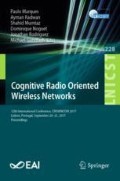Abstract
This work evaluates the secondary users’ (SUs) transmission capability considering that the primary users (PUs) can move to different positions. The transmission capability identifies the available opportunities for SU’s transmission. No opportunities are available when mobile PUs are active within the SU’s sensing region. We also consider the scenario when the PUs are undesirable detected active when they are not located within the SUs’ sensing region. Our analysis indicate that the transmission capability increases as the average mobility of the PUs decreases, which is confirmed by simulation.
Access this chapter
Tax calculation will be finalised at checkout
Purchases are for personal use only
Notes
- 1.
For every PU we have assumed P Tx = 103 mW.
References
Yucek, T., Arslan, H.: A survey of spectrum sensing algorithms for cognitive radio applications. IEEE Commun. Surv. Tutorials 11, 116–130 (2009)
Urkowitz, H.: Energy detection of unknown deterministic signals. Proc. IEEE 55, 523–531 (1967)
Zahedi-Ghasabeh, A., Tarighat, A., Daneshrad, B.: Spectrum sensing of OFDM waveforms using embedded pilots in the presence of impairments. IEEE Trans. Veh. Technol. 61, 1208–1221 (2012)
Bouzegzi, A., Ciblat, P., Jallon, P.: Matched filter based algorithm for blind recognition of OFDM systems. In: Proceedings of IEEE VTC 2008-Fall, pp. 1–5, September 2008
Al-Habashna, A., Dobre, O.A., Venkatesan, R., Popescu, D.C.: Cyclostationarity- based detection of LTE OFDM signals for cognitive radio systems. In: Proceedings of IEEE GLOBECOM 2010, pp. 1–6, December 2010
Masonta, M.T., Mzyece, M., Ntlatlapa, N.: Spectrum decision in cognitive radio networks: a survey. IEEE Commun. Surv. Tutorials 15, 1088–1107 (2013)
Sun, H., Nallanathan, A., Wang, C.-X., Chen, Y.: Wideband spectrum sensing for cognitive radio networks: a survey. IEEE Wirel. Commun. 20, 74–81 (2013)
Lee, W.-Y., Akyildiz, I.F.: Optimal spectrum sensing framework for cognitive radio networks. IEEE Trans. Wireless Commun. 7, 3845–3857 (2008)
Cacciapuoti, A.S., Akyildiz, I.F., Paura, L.: Primary-user mobility impact on spectrum sensing in cognitive radio networks. In: 22nd IEEE International Symposium on Personal, Indoor and Mobile Radio Communications, pp. 451–456, Toronto (2011)
Cacciapuoti, A.S., Akyildiz, I.F., Paura, L.: Optimal primary-user mobility aware spectrum sensing design for cognitive radio networks. IEEE J. Sel. Areas Commun. 31, 2161–2172 (2013)
Han, W., Li, J., Liu, Q., Zhao, L.: Spatial false alarms in cognitive radio. IEEE Commun. Lett. 15, 518–520 (2011)
Han, W., Li, J., Li, Z., Si, J., Zhang, Y.: Spatial false alarm in cognitive radio network. IEEE Trans. Sig. Process. 61, 1375–1388 (2013)
Johnson, D.B., Maltz, D.A.: Dynamic source routing in ad hoc wireless networks. Mob. Comput. 353, 153–181 (1996)
Bettstetter, C., Resta, G., Santi, P.: The node distribution of the random way- point mobility model for wireless ad hoc networks. IEEE Trans. Mob. Comput. 2, 257–269 (2003)
Haenggi, M., Ganti, R.K.: Interference in large wireless networks. Found. Trends Netw. 3, 127–248 (2009)
Moschopoulos, P.G.: The distribution of the sum of independent gamma random variables. Ann. Inst. Stat. Math. 37, 541–544 (1985)
Acknowledgments
This work was partially supported by the Portuguese Science and Technology Foundation (FCT/MEC) under the project UID/EEA/50008/2013 and grant SFRH/BD/108525/2015. The work was also supported by the “Faculdade de Cincias e Tecnologia” - Nova University of Lisbon, through the PhD Program in Electrical and Computer Engineering.
Author information
Authors and Affiliations
Corresponding author
Editor information
Editors and Affiliations
Rights and permissions
Copyright information
© 2018 ICST Institute for Computer Sciences, Social Informatics and Telecommunications Engineering
About this paper
Cite this paper
Irio, L., Oliveira, R. (2018). Impact of Mobility in Spectrum Sensing Capacity. In: Marques, P., Radwan, A., Mumtaz, S., Noguet, D., Rodriguez, J., Gundlach, M. (eds) Cognitive Radio Oriented Wireless Networks. CrownCom 2017. Lecture Notes of the Institute for Computer Sciences, Social Informatics and Telecommunications Engineering, vol 228. Springer, Cham. https://doi.org/10.1007/978-3-319-76207-4_14
Download citation
DOI: https://doi.org/10.1007/978-3-319-76207-4_14
Published:
Publisher Name: Springer, Cham
Print ISBN: 978-3-319-76206-7
Online ISBN: 978-3-319-76207-4
eBook Packages: Computer ScienceComputer Science (R0)

